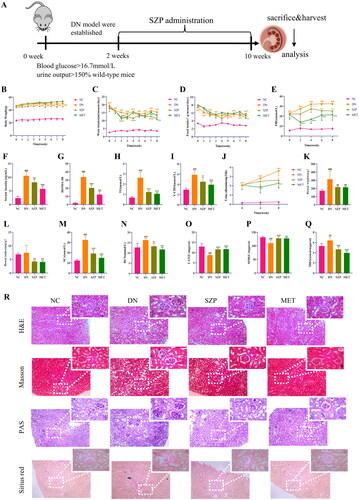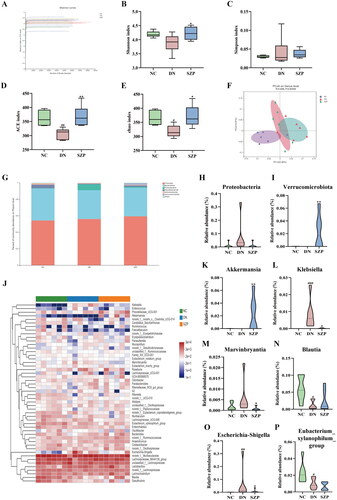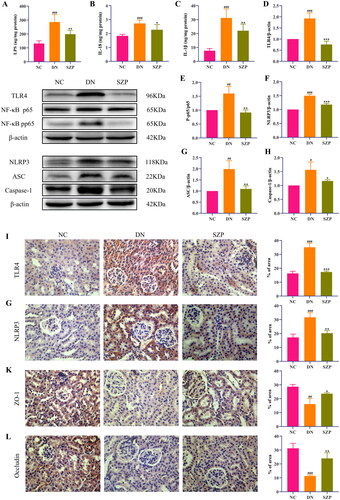Figures & data
Table 1. Composition of SZP.
Figure 1. Sanziguben polysaccharides (SZP) ameliorated renal injury in diabetic nephropathy (DN) mice after 8 weeks of administration. (A) Study flow diagram, (B) body weight, (C) water intake, (D) food intake, (E) fasting blood glucose (FBG), (F) serum insulin, (G) the homeostasis model assessment of insulin resistance (HOMA-IR) index, (H) triglyceride (TG), (I) total cholesterol (T-CHO), (J) urine albumin, (K) renal weight, (L) renal index, (M) serum creatinine (SCr), (N) blood urea nitrogen (BUN), (O) catalase (CAT), (P) superoxide dismutase (SOD), (Q) malondialdehyde (MDA), (R) histology (haematoxylin and eosin (H&E), periodic acid-Schiff (PAS), Masson and Sirius red staining). All data were expressed as the mean ± SD (n = 6). ##p< 0.01, ###p< 0.001 vs. NC group; *p< 0.05, **p< 0.01, ***p< 0.001 vs. DN group.

Figure 2. Sanziguben polysaccharides (SZP) improved gut microbiota in diabetic nephropathy (DN) mice. (A) Shannon index curve. The alpha diversity of the gut microbiome: (B) ACE index, (C) Chao index, (D) Shannon index and (E) Simpson index. (F) Unweighted UniFrac PCoA (principal coordinates analysis). (G) Relative abundance of intestinal microbiota at the phylum level, (H) Proteobacteria and (I) Verrucomicrobiota. (J)Abundance changes in representative bacteria at the genus level are shown in a heatmap. Genera that were statistically different with SZP treatment: the relative abundance of (K) Akkermansia, (L) Klebsiella, (M) Marvinbryantia, (N) Blautia, (O) Escherichia-Shigella and (P) Eubacterium_xylanophilum_group. All data were expressed as the mean ± SD (n = 6). #p< 0.05, ##p< 0.01, ###p< 0.001 vs. NC group; *p< 0.05, **p< 0.01 vs. DN group.

Figure 3. Sanziguben polysaccharides (SZP) inhibited the inflammatory factors, altered the protein levels of the TLR4/NF-κB/NLRP3 pathway and kidney barrier in kidney tissues. (A) Lipopolysaccharide (LPS), (B) interleukin (IL)-18 and (C) IL-1β levels in kidney were determined by enzyme-linked immunosorbent assay (ELISA) (n = 6, mean ± SD). Expression of (D) TLR4, (E) the ratio of NF-κB p-p65 to NF-κB p65, (F) NLRP3, (G) ASC, (H) caspase-1, evaluated by western blot analysis (n = 3, mean ± SD). Representative immunohistochemistry (IHC) result for (I) TLR4, (G) NLRP3, (K) ZO-1, (L) occludin (n = 3, mean ± SD). ##p< 0.01, ###p< 0.001 vs. NC group; *p< 0.05, **p< 0.01, ***p< 0.001 vs. diabetic nephropathy (DN) group.


